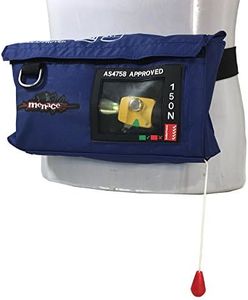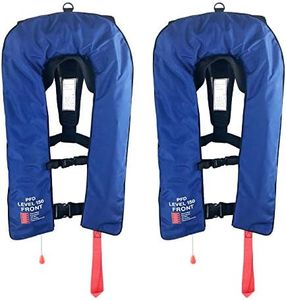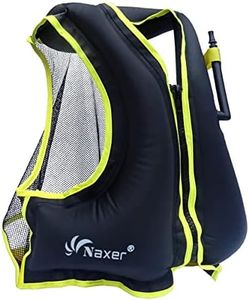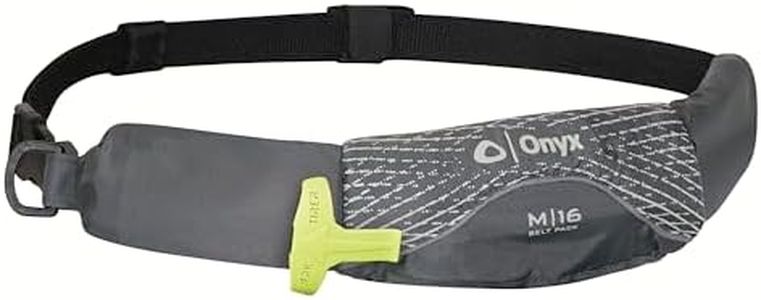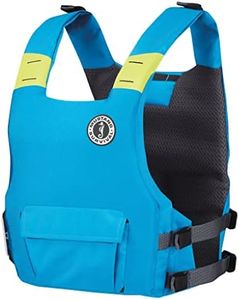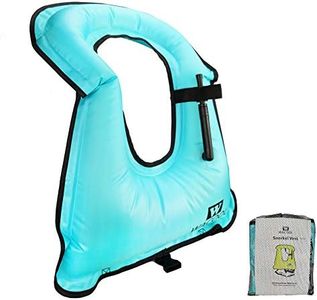We Use CookiesWe use cookies to enhance the security, performance,
functionality and for analytical and promotional activities. By continuing to browse this site you
are agreeing to our privacy policy
10 Best Inflatable Life Jackets
From leading brands and best sellers available on the web.Buying Guide for the Best Inflatable Life Jackets
Selecting an inflatable life jacket is an important step in ensuring safety while enjoying activities on the water, such as boating, fishing, or kayaking. Inflatable life jackets are appreciated for their comfort, lightweight design, and ease of movement compared to traditional foam life jackets. However, with many options available, it's crucial to understand the key features and specifications so you can pick a jacket that matches your needs and activities. Thinking about how and where you'll use the life jacket—like calm lakes, rivers, or open seas—will guide you toward the best fit for your safety and comfort.Buoyancy RatingBuoyancy rating refers to how much flotation the life jacket provides and is measured in pounds or Newtons. This is important because buoyancy is what keeps you afloat in the water. Most inflatable life jackets for adults offer a range around 22-34 pounds (100-150 Newtons). Lower buoyancy (around 22 lbs) is often suitable for calm, inland waters where help is nearby, while higher buoyancy (over 30 lbs) is designed for rougher water or offshore use where self-rescue may take longer. When picking a life jacket, consider the conditions you’ll be in—open water and heavy gear may require greater buoyancy.
Inflation Type (Manual or Automatic)Inflation type identifies how the jacket inflates—either manually by pulling a cord or automatically when it comes into contact with water. This is important because it affects how quickly the jacket will provide flotation. Manual-only jackets are suitable for confident swimmers and situations where you don’t want it to inflate by accident (like kayaking or paddleboarding). Automatic jackets are better for situations where you might not be conscious or able to pull the cord, such as fishing alone or in unpredictable conditions. Think about your usual water activity and whether you want inflation to happen automatically or by your own action.
Fit and AdjustabilityFit and adjustability describe how well the jacket can be secured to your body and personalized for comfort. A good fit is crucial because a loose life jacket can slip off or fail to keep your head above water. Inflatable life jackets usually have adjustable straps for the waist and sometimes the chest. Small, medium, and large adjustments cater to different body types. When choosing, look for a jacket you can tighten snugly but comfortably. Try it on whenever possible, and make sure it won’t shift around when you move.
Visibility FeaturesVisibility features include bright colors, reflective strips, and safety whistles, all of which make it easier for rescuers to spot you in the water. High visibility is especially important if you’re boating in busy areas, at night, or in rough weather. Life jackets with bright neon or orange fabrics and multiple reflective patches are preferred for maximum visibility. Choose a model that stands out and incorporates reflective materials if you'll be on larger bodies of water or in settings with limited visibility.
Maintenance and Re-armingMaintenance and re-arming refers to the process of checking and replacing the CO2 cylinder and other components after the life jacket has been inflated, whether accidentally or during an emergency. This is important because inflatable jackets require regular inspection and upkeep to ensure they work when needed. Some jackets are easier to re-arm and have indicators showing readiness, while others require more frequent checks and knowledge about replacement parts. If you prefer low-maintenance gear, seek models with simple, clear re-arming instructions and visible status indicators. Always familiarize yourself with the re-arming process so you’re confident the life jacket will work reliably.
